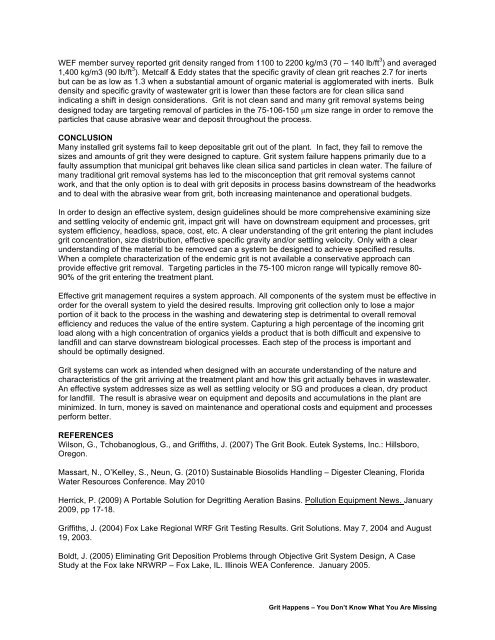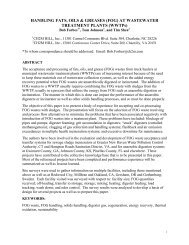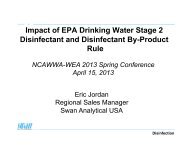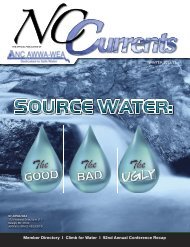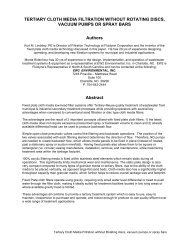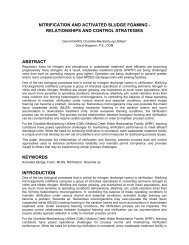GRIT HAPPENS â YOU DON'T KNOW WHAT YOU ARE MISSING
GRIT HAPPENS â YOU DON'T KNOW WHAT YOU ARE MISSING
GRIT HAPPENS â YOU DON'T KNOW WHAT YOU ARE MISSING
- No tags were found...
Create successful ePaper yourself
Turn your PDF publications into a flip-book with our unique Google optimized e-Paper software.
WEF member survey reported grit density ranged from 1100 to 2200 kg/m3 (70 – 140 lb/ft 3 ) and averaged1,400 kg/m3 (90 lb/ft 3 ). Metcalf & Eddy states that the specific gravity of clean grit reaches 2.7 for inertsbut can be as low as 1.3 when a substantial amount of organic material is agglomerated with inerts. Bulkdensity and specific gravity of wastewater grit is lower than these factors are for clean silica sandindicating a shift in design considerations. Grit is not clean sand and many grit removal systems beingdesigned today are targeting removal of particles in the 75-106-150 µm size range in order to remove theparticles that cause abrasive wear and deposit throughout the process.CONCLUSIONMany installed grit systems fail to keep depositable grit out of the plant. In fact, they fail to remove thesizes and amounts of grit they were designed to capture. Grit system failure happens primarily due to afaulty assumption that municipal grit behaves like clean silica sand particles in clean water. The failure ofmany traditional grit removal systems has led to the misconception that grit removal systems cannotwork, and that the only option is to deal with grit deposits in process basins downstream of the headworksand to deal with the abrasive wear from grit, both increasing maintenance and operational budgets.In order to design an effective system, design guidelines should be more comprehensive examining sizeand settling velocity of endemic grit, impact grit will have on downstream equipment and processes, gritsystem efficiency, headloss, space, cost, etc. A clear understanding of the grit entering the plant includesgrit concentration, size distribution, effective specific gravity and/or settling velocity. Only with a clearunderstanding of the material to be removed can a system be designed to achieve specified results.When a complete characterization of the endemic grit is not available a conservative approach canprovide effective grit removal. Targeting particles in the 75-100 micron range will typically remove 80-90% of the grit entering the treatment plant.Effective grit management requires a system approach. All components of the system must be effective inorder for the overall system to yield the desired results. Improving grit collection only to lose a majorportion of it back to the process in the washing and dewatering step is detrimental to overall removalefficiency and reduces the value of the entire system. Capturing a high percentage of the incoming gritload along with a high concentration of organics yields a product that is both difficult and expensive tolandfill and can starve downstream biological processes. Each step of the process is important andshould be optimally designed.Grit systems can work as intended when designed with an accurate understanding of the nature andcharacteristics of the grit arriving at the treatment plant and how this grit actually behaves in wastewater.An effective system addresses size as well as settling velocity or SG and produces a clean, dry productfor landfill. The result is abrasive wear on equipment and deposits and accumulations in the plant areminimized. In turn, money is saved on maintenance and operational costs and equipment and processesperform better.REFERENCESWilson, G., Tchobanoglous, G., and Griffiths, J. (2007) The Grit Book. Eutek Systems, Inc.: Hillsboro,Oregon.Massart, N., O’Kelley, S., Neun, G. (2010) Sustainable Biosolids Handling – Digester Cleaning, FloridaWater Resources Conference. May 2010Herrick, P. (2009) A Portable Solution for Degritting Aeration Basins. Pollution Equipment News. January2009, pp 17-18.Griffiths, J. (2004) Fox Lake Regional WRF Grit Testing Results. Grit Solutions. May 7, 2004 and August19, 2003.Boldt, J. (2005) Eliminating Grit Deposition Problems through Objective Grit System Design, A CaseStudy at the Fox lake NRWRP – Fox Lake, IL. Illinois WEA Conference. January 2005.Grit Happens – You Don’t Know What You Are Missing


